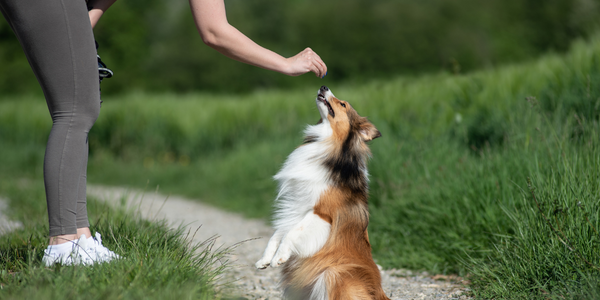If unwanted dog behaviours and training are on your top priority list, you're not alone. Jumping, a very common unwanted dog behaviour is one of the most common behaviors dog guardians want to overcome. But decreasing jumping is as much about changing a human’s behavior as it is about changing the dog’s.

Get the treat pouch ready when you’re working on training!
How you respond to a jumping dog is important, and it all comes down to action and consequence.
If your dog jumps on you while playing with a toy, don’t keep playing; drop the toy and walk away.
If your dog jumps on you while you’re preparing their meal, don’t push them away; walk completely away from the food (making sure it’s not accessible to your jumping dog).
If your dog jumps on you when you come home, don’t enter the house; wait briefly outside for your dog to calm down.
In all of these scenarios, your dog WANTS something—your attention, food, or to play with a toy. This motivates them to jump, bringing them closer to the object of their desire.
To change the behavior, your dog has to understand that not only does jumping not work to get them what they want, but it also makes the object of their desire disappear or go farther away. In other words, by removing the reward, your dog has to attempt another strategy to get what they want.
When you see them make that attempt at an alternate behavior—for example, sitting when you walk in the door instead of jumping, reward them heavily for it.
The more a dog is rewarded for a behavior, the more frequently they will practice it!
Changing a natural impulse
This process doesn’t happen overnight. What’s even more frustrating is that before you see an improvement in the behavior, you’re likely to see it get worse. This is called an “extinction burst,” and it’s your dog’s last all-out attempt to do the behavior that comes naturally to them in order to get what they want.
But stick to your guns! If you can use these strategies consistently, over time, you’ll see a lasting change take effect.
If your dog becomes overly excited and jumps up on you:
Turn your back. Do not push your dog off with your hands. They will probably think, at the very least, that jumping wins their attention, if not that you’re playing with them. NEVER knee your dog when they jump on you. This is painful and dangerous.
If you’ve turned your back once or twice and your dog is still jumping on you, let them know this behavior isn’t acceptable by telling them, “Too bad!” and walking away from them, putting a closed door or baby gate between you.
When your dog is calm, you may return to interacting with them.
If your dog jumps on you when you come home
Open the door part-way. If your dog is overly excited and one or more of their paws are off the ground, immediately close the door and wait for 30 seconds.
Begin to open the door again. If your dog is still jumping around, close the door and wait another 30 seconds.
Continue closing the door and waiting until your dog is calm enough for you to walk in without them jumping on you.
If your dog jumps on friends when they come to visit
Put your dog on a leash and unlock the door for your guest. Instruct them ahead of time to knock when they arrive (to alert you) but to enter on their own and wait in the entryway for you to come and greet them.
When your guest has entered, bring your dog close enough to see them but far enough away that they cannot reach your guest. Ask your dog for a sit.
Have your friend walk toward you but ask them to stop and stand still if your dog becomes too excited and stands up. When this happens, calmly get your dog’s attention and ask them to sit. When seated, your friend can begin walking forward again.
Repeat Step 3 until your friend reaches your dog with all four paws still on the floor. When they arrive, let the two say hello!
If your dog jumps on strangers saying hello at the park
Ask the friendly stranger if they would spend a moment helping you to teach your pup polite greetings. Ask the stranger to stand still and let you come to them.
Begin walking your dog toward the stranger to say hello. If your dog gets too excited—tugging on the leash, bouncing around, barking, and so on—get their attention back on you while backing up a step or two.
Give your dog a moment to calm down (standing or sitting is OK), then begin to approach the person again. Repeat Step 2 each time your dog gets too excited to greet you.
When you’ve made it to your new friend with all four of your dog’s paws on the ground, allow them to say hello
Shoshi Parks, Ph.D. is a Certified Professional Dog Trainer (CPDT-ka) and Certified Separation Anxiety Trainer (CSAT).